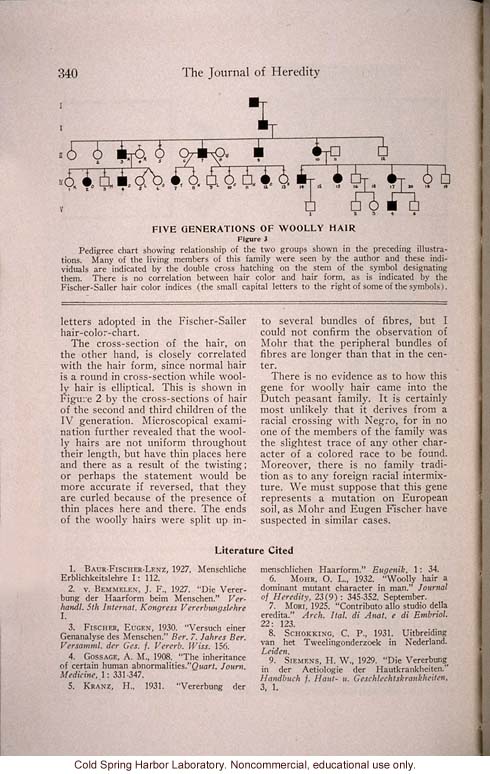"Another Wooly-Hair Mutation in Man," by C.Ph. Schokking, Journal of Heredity (vol. 25) (4)

'"""Sterilization for Ten Million Americans,"" by J.H. Kempton, The Journal of Heredity, American Genetic Association, page 415"'
2316. 340 The Journal of Heredity [pedigree chart] Five Generations of Woolly Hair Figure 3 Pedigree chart showing relationship of the two groups shown in the preceding illustrations. Many of the living members of this family were seen by the author and these individuals are indicated by the double cross hatching on the stem of the symbol designating them. There is no correlation between hair color and hair form, as is indicated by the Fischer-Saller hair color indices (the small capital letters to the right of some of the symbols). [double hairline score page width] letters adopted in the Fischer-Saller hair-color-chart. The cross-section of the hair, on the other hand, is closely correlated with the hair form, since normal hair is a round in cross-section while woolly hair is elliptical. This is shown in Figure 2 by the cross-sections of hair of the second and third children of the IV generation. Microscopical examination further revealed that the woolly hairs are not uniform throughout their length, but have thin places here and there as a result of the twisting; or perhaps the statement would be more accurate if reversed, that they are curled because of the presence of thin places here and there. The ends of the woolly hairs were split up into several bundles of fibres, but I could not confirm the observation of Mohr that the peripheral bundles of fibres are longer than that in the center. There is no evidence as to how this gene for woolly hair came into the Dutch peasant family. It is certainly most unlikely that it derives from a racial crossing with Negro, for in no one of the members of the family was the slightest trace of any other character of a colored race to be found. Moreover, there is no family tradition as to any foreign racial intermixture. We must suppose that this gene represents a mutation on European soil, as Mohr and Eugen Fischer have suspected in similar cases. Literature Cited 1. Baur-Fischer-Lenz, 1927. Menschliche Erblichkeitslehre I: 112. 2. v. Bemmelen, J. F., 1927. "Die Vererbung der Haarform beim Menschen." [italics]Verhandl. 5th Internat. Kongress Vererbungslehre[end italics] I. 3. Fischer, Eugen, 1930. "Versuch einer Genanalyse des Menschen." [italics]Ber. 7. Jahres Ber. Versamml. Der Ges. F. Vererb. Wiss.[end italics] 156. 4. Gossage, A. M., 1908. "The inheritance of certain human abnormalities." [italics]Quart. Journ. Medicine[end italics], 1:331-347. 5. Kranz, H., 1931. "Verebung der menschlichen Haarform." [italics]Eugenik[end italics], 1: 34. 6. Mohr, O. L., 1932. "Woolly hair a dominant mutant character in man." [italics]Journal of Heredity[end italics], 23(9): 345-352. September. 7. Mori, 1925. "Contributo allo studio della eredita." [italics]Arch. Ital. De Anat. E di Embriol.[end italics] 22: 123. 8. Schokking, C. P., 1931. Uitbreiding van het Tweelingonderzoek in Nederland. [italics]Leiden[end italics]. 9. Siemens, H. W., 1929. "Die Vererbung in der Aetiologie der Hautkrankheiten." [italics]Handbuch f. Haut- u. Geschlechtskrankheiten[end italics], 3, 1. [end]
- ID: 12216
- Source: DNALC.EA


